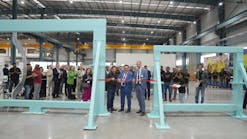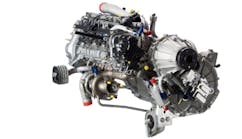Engine Compression
Back to basics
By Joe Escobar
Compression testing can be an effective tool for monitoring engine condition. Despite the apparent simplicity of the test, it can be a valuable resource to determine engine wear and internal damage at an early stage, thus avoiding potentially catastrophic failures. But care must be taken to ensure the test is performed properly in order to avoid unnecessary maintenance actions to a perfectly good cylinder. In this article, we will go back to the basics of engine compression testing.
Compression testing
Compression testing is basically a test to determine the amount of leakage past the piston rings and valves in an engine cylinder. The type of compression test used for aircraft engines is a differential compression test. This is somewhat different from a direct compression test commonly used in testing automotive engines.
Direct compression testing. In a direct compression test, a pressure gauge is installed into the spark plug boss of the engine. The engine is then turned over and the peak pressure buildup in the cylinder is determined. This type of compression test can yield varying results and depends on many variables to be reliable.
Differential compression testing. Differential compression testing is a more reliable method of testing engine compression. The test uses two gauges to measure pressure. Compressed air is applied to the tester through the regulator gauge. This gauge indicates the air pressure being applied to the tester. The air then goes through a calibrated restrictor to the cylinder pressure gauge. This gauge indicates the actual pressure in the cylinder. Any compression loss in the cylinder would be indicated by a pressure indication in the cylinder pressure gauge lower than that of
the regulator gauge.
Testing the tester
In differential compression testing, the tester is a critical element
to ensure accurate test results are obtained. Needless to say, there are a few things we should keep in mind in regards to the tester to ensure it will give us the precise measurements we need.
Dead-end check. A good way to test your differential tester for proper operation is to "dead-end" it. You basically cap off the end of the tester that would normally go into the cylinder and apply regulated air pressure to the tester. You want to ensure that both the pressure regulator gauge and the cylinder pressure gauge stabilize out at the same pressure reading. Any difference in pressure indication could mean leaks in the tester or defective gauges. The tester can then be repaired as necessary.
Your tester could have a valve installed between the cylinder pressure gauge and the cylinder. You should close this valve in order to perform the check. Keep in mind, this is another area that can leak causing a difference in gauge readings during the unit test. The valve should be eliminated as a leak source before looking at the gauges for leaks or inaccuracy.
Storage
Another factor that can affect the accuracy of your tester is debris. Any contaminants such as dirt and oil can adversely affect the readings. The tester should be treated as a precision measuring device, not as just a hand tool. It should be kept clean at all times to help ensure accuracy of tests.
Proper orifice
An important thing to keep in mind is to ensure you are using the proper orifice in your tester for the engine being inspected. As a general guideline, AC 41.13-1B states that the restrictor orifice dimensions in the differential pressure tester should be sized for the particular engine as follows:
- Engines up to 1,000-cubic-inch displacement: 0.040-inch orifice diameter, 0.250 inch long, 60-degree approach angle.
- Engines in excess of 1,000-cubic-inch displacement: 0.060-inch orifice diameter, 0.250 inch long, 60-degree approach angle.
Engine manufacturers may have other requirements for their engines. Be sure that you consult the manufacturer's maintenance manuals and service bulletins for specific testing requirements.
Getting started
Once you have dead-end checked your tester and know you have the proper orifice installed, you are ready to test the engine. Test procedures can be found in AC 43.13-1B, Lycoming Flyer Key Reprints, Lycoming Service Instruction 1191A, and TCM Service Bulletin SB03-3. The basics of performing a differential test are as follows.
Special needs
You want to make sure you have a source of dry compressed air capable of providing a minimum line pressure of 125 psi with a minimum flow capability of 15 cubic feet per minute. In addition, you need to have a differential tester. Refer to the engine manufacturer for approved testers. In addition, for Teledyne Continental engines, depending on the tester you are using,
you may also need a master orifice tool P/N 646953A to determine the Minimum Acceptable Leak Limit for your engine.
Warm up that engine
It is recommended that the compression test be performed on a hot engine. This ensures that the piston rings, cylinder walls, and other engine parts are well lubricated and at operating clearance. For example, in SB03-3 Teledyne Continental states:
"Ideally, perform the cylinder differential pressure test as soon as possible after the aircraft has been flown. If the aircraft cannot be flown prior to performing the cylinder differential pressure test, it must be operated on the ground, with the cowling installed until a minimum cylinder head temperature (CHT) of 300 F to 350 F is observed on the aircraft gauge. For aircraft fitted with constant speed propellers operate the engine at a high enough power setting to allow the cycling of the aircraft propeller. For aircraft with fixed pitched propeller, operate the engine to full static rpm."
Although it is a recommended practice to perform the test on a hot engine, some mechanics still choose to perform compression tests on a cold engine. This may be OK in some cases, but it could also lead to low readings. The engine may end up having to be run anyway due to low readings. It won't hurt you to run the engine in the first place, but failing to do
so could lead to more work in the long run.
Some safety issues
Magnetos should be grounded and fuel should be shut off prior to performing
a test in order to make certain that the engine will not accidentally start.
Howard Siedlecki, president of Kenosha, WI-based Sunshine Aircraft Repair Inc., discusses his habit of disconnecting all spark plug leads prior to starting the compression test as an added safety measure. "I disconnect all spark plug leads from the spark plugs prior to performing a compression test. This is a good practice to get into, as it is an additional safety measure to prevent the engine from accidentally starting during the test."
Hooking up the tester
Now, you want to connect the tester. You will need to remove one of the spark plugs on each cylinder to perform the test. The most accessible one should be removed, and that will vary depending on the engine and airframe you are working on. Of course, be sure to place the spark plugs in a spark plug tray upon removal and keep them separated to ensure installation in the same position. Also, an inspection of the spark plugs is a good thing to do at this point. This will help you diagnose the condition of the engine and cylinder.
Now you can connect the cylinder adapter to the cylinder being tested at the spark plug boss. You will then want to find top dead center (TDC) of the piston in the cylinder. A trick of the trade to find TDC of the cylinder is to place your finger over the cylinder adapter. Then rotate the propeller through in its normal rotation direction. As the piston approaches TDC, a small amount of air will be forced out of the adapter, stopping when the piston passes TDC.
Applying pressure
Now it is time to hook up the differential tester to the cylinder adapter. Before connecting the tester to the adapter, you want to ensure that the cylinder pressure valve is closed.
Before pressurizing the cylinder, make sure that a co-worker has a good grip on the propeller. Another couple of safety items are important to keep in mind. Since two of you will be working on the test together, one to operate the tester and the other to hold the propeller securely, clear communication is essential. Also, make sure that neither worker is standing in the path of the propeller just in case it slips away during the test. Also ensure the area around the propeller is free from any obstruction that could interfere with the test or cause damage should the propeller accidentally get away from the person holding it.
Once you have the piston close to its TDC position, you can adjust the pressure regulator on the tester so that the regulator pressure gauge reads around 20 psi. With a co-worker securely holding the propeller blade, slowly open the air valve. You should use care when opening the valve
since the propeller will rotate quickly if the piston is not at TDC. Once you have the valve open, the person holding the propeller wants to ensure that the piston is in its TDC position. This is done by slowly rotating the propeller in the direction of normal rotation. Reaching TDC is indicated by a flat spot or sudden decrease in force required to turn the propeller. If the propeller is pulling in the direction of normal rotation, then you have passed TDC. If this happens, you want to back up about one-half revolution and rotate it through again in order to eliminate the effect of backlash in the valve operating mechanism and to keep the piston rings seated on the lower ring lands.
Once you are sure the piston is at TDC, you can open the air valve to 80 psi. You should check the regulated air pressure and readjust it as necessary to read 80 psi. Be careful when adjusting the regulator as going over 80 psi can put excessive pressure on the piston and therefore the propeller may want to get away from the person holding it. To ensure that the piston rings are seated, the person holding the propeller can move the propeller slightly back and forth in a rocking motion in order to
obtain the highest indication. Be sure to adjust the regulator as necessary to maintain a regulated pressure indication of 80 psi.
Interpreting readings
Now you will take a reading on the tester. This is annotated as the actual amount of pressure in the cylinder over the regulated pressure. For example, if the cylinder gauge indicates 60 psi and the regulated pressure indicates 80 psi, then your compression is 60/80. In general, 60/80 is the minimum acceptable leak limit. Keep in mind if you are working on a TCM engine, you will use the limit determined using the Master Orifice Tool.
What next?
If your indications are low, that doesn't warrant immediately pulling the cylinder. A little more investigation is in order. The engine manufacturers have guidelines on inspection procedures to coincide with compression tests to help determine the health of the cylinder and the disposition should a reading be below the minimum limit. Be sure to refer to the manufacturer's instructions for proper procedures and troubleshooting techniques.
This has been a primer on differential compression testing. For detailed
inspection procedures and maintenance criteria, be sure to refer to the manufacturer's instructions.
Determining Minimum Acceptable Leak Limits for TCM engines
If performing a differential compression test on a Teledyne Continental engine, these are the steps for determining the Minimum Acceptable Pressure Leakage Limit using a standard differential pressure tester and Master Orifice Tool P/N 646953:
a) Make sure the Regulator Pressure Valve is backed all the way OUT.
b) Make sure the Cylinder Pressure Valve is OFF or Closed.
c) Remove the protective caps from both ends of the Master Orifice and install the Master Orifice onto the threaded end of the cylinder adapter and tighten hand tight.
d) Connect the cylinder adapter with Master Orifice attached to the female quick connection on the supply hose from the differential test unit.
e) Connect your air source to the tester at the male quick connection fitting.
f) Adjust pressure regulator so regulator pressure gauge reads 80 psi.
g) Turn the cylinder pressure valve to the ON or OPEN position.
h) If necessary, adjust the pressure regulator to maintain a reading of 80 psi on the regulator pressure gauge.
i) Record the pressure reading on the cylinder pressure gauge. This reading is the Minimum Acceptable Pressure Leakage Limit.
j) Turn the cylinder pressure valve to the CLOSED or OFF position.
k) Remove the cylinder adapter and Master Orifice from the female quick connection on the supply hose from the differential test unit.
l) Remove the Master Orifice from the cylinder adapter.
- Teledyne Continental Service Bulletin SB03-3
ADDITIONAL RESOUCES
Advisory Circular 43.13-1B
Lycoming
(570) 323-6181
www.lycoming.textron.com
Teledyne Continental Motors
(800) 718-3411
(251) 438-3411
www.tcmlink.com




